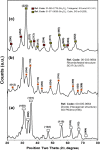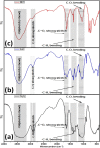Metal-based-oxide nanoparticles assisted the in vitro culture growth of Populus alba as micronutrients: essential metabolic processes and genetic stability
- PMID: 37063726
- PMCID: PMC10099765
- DOI: 10.1039/d2ra05941j
Metal-based-oxide nanoparticles assisted the in vitro culture growth of Populus alba as micronutrients: essential metabolic processes and genetic stability
Abstract
The present study evaluates the in vitro culture growth rate of Populus alba upon using nano metal-based-oxides such as hematite (Fe2O3 NPs), zinc oxide (ZnO NPs), and manganese oxide (Mn2O3 NPs) nanoparticles as analogues of three primary micronutrients such as iron (Fe), zinc (Zn), and manganese (Mn), which exist in soil as micronutrients. Herein, the in vitro culture growth rate was investigated using three different concentrations (i.e., 20, 40, and 60 mg L-1) of as-prepared metal oxide nanoparticles compared to the control. In addition, the as-prepared nanoparticles have been prepared via the co-precipitation method. Furthermore, the physicochemical properties were investigated using transmission electron microscopy, Fourier transform infrared spectroscopy, X-ray diffraction, and dynamic light scattering techniques. Overall, a significant difference in the biomass production-related parameters such as fresh weight, shoot length, and root length was observed compared to the control upon the treatment with micronutrient-based nano-metal-oxides (i.e., Mn2O3 > Fe2O3 > ZnO NPs, respectively). In addition, a significant increase in the root number of Populus alba plants upon their treatment with ZnO NPs was observed compared to other prepared nano-metal-oxides and the control. Also, a remarkable increase in the chlorophyll index was monitored upon the treatment with Fe2O3 NPs rather than the other commonly used Mn2O3 and ZnO NPs, respectively. Moreover, RAPD-PCR bioassays were applied, and the actual six primers showed a genetic variation percentage of 34.17%, indicating that Populus alba is highly genetically stable even in highly contaminated soil. As a result, our findings suggest an idea that indicates the ability to enhance the in vitro culture growth rate of Populus alba plants using metal oxide nanoparticles as analogous to essential micronutrients.
This journal is © The Royal Society of Chemistry.
Conflict of interest statement
There are no conflicts to declare.
Figures










References
-
- Ali H. Khan E. Ilahi I. J. Chem. 2019;2019:6730305.
-
- Asati A. Pichhode M. Nikhil K. Int. j. appl. innov. eng. manag. 2016;5:56–66.
LinkOut - more resources
Full Text Sources
Research Materials
Miscellaneous

